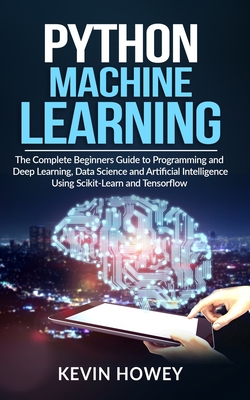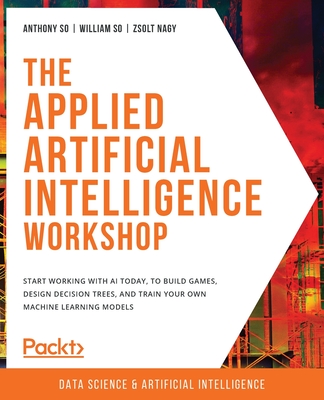Make Your Own Neural Network: An In-depth Visual Introduction For Beginners
暫譯: 打造自己的神經網絡:初學者的深入視覺導覽
Michael Taylor
- 出版商: Independently published
- 出版日期: 2017-10-04
- 售價: $580
- 貴賓價: 9.5 折 $551
- 語言: 英文
- 頁數: 248
- 裝訂: Paperback
- ISBN: 1549869132
- ISBN-13: 9781549869136
-
相關分類:
DeepLearning、DeepLearning
立即出貨(限量) (庫存=1)
買這商品的人也買了...
-
 Expert C Programming: Deep C Secrets (Paperback)
Expert C Programming: Deep C Secrets (Paperback)$1,720$1,634 -
 Pointers on C
Pointers on C$9,370$8,902 -
 The C Puzzle Book
The C Puzzle Book$1,130$1,074 -
 Grokking Deep Learning (Paperback)
Grokking Deep Learning (Paperback)$1,750$1,663 -
 $327生成對抗網絡入門指南 (Generative adversarial Networks)
$327生成對抗網絡入門指南 (Generative adversarial Networks) -
 Introduction to Deep Learning (Hardcover)
Introduction to Deep Learning (Hardcover)$1,450$1,378
相關主題
商品描述
A step-by-step visual journey through the mathematics of neural networks, and making your own using Python and Tensorflow.
What you will gain from this book:
* A deep understanding of how a Neural Network works. * How to build a Neural Network from scratch using Python.
Who this book is for:
* Beginners who want to fully understand how networks work, and learn to build two step-by-step examples in Python. * Programmers who need an easy to read, but solid refresher, on the math of neural networks.
What’s Inside - ‘Make Your Own Neural Network: An Indepth Visual Introduction For Beginners’
What Is a Neural Network?
Neural networks have made a gigantic comeback in the last few decades and you likely make use of them everyday without realizing it, but what exactly is a neural network? What is it used for and how does it fit within the broader arena of machine learning?
we gently explore these topics so that we can be prepared to dive deep further on. To start, we’ll begin with a high-level overview of machine learning and then drill down into the specifics of a neural network.
The Math of Neural Networks
On a high level, a network learns just like we do, through trial and error. This is true regardless if the network is supervised, unsupervised, or semi-supervised. Once we dig a bit deeper though, we discover that a handful of mathematical functions play a major role in the trial and error process. It also becomes clear that a grasp of the underlying mathematics helps clarify how a network learns.
* Forward Propagation * Calculating The Total Error * Calculating The Gradients * Updating The Weights
Make Your Own Artificial Neural Network: Hands on Example
You will learn to build a simple neural network using all the concepts and functions we learned in the previous few chapters. Our example will be basic but hopefully very intuitive. Many examples available online are either hopelessly abstract or make use of the same data sets, which can be repetitive. Our goal is to be crystal clear and engaging, but with a touch of fun and uniqueness. This section contains the following eight chapters.
Building Neural Networks in Python
There are many ways to build a neural network and lots of tools to get the job done. This is fantastic, but it can also be overwhelming when you start, because there are so many tools to choose from. We are going to take a look at what tools are needed and help you nail down the essentials. To build a neural network
Tensorflow and Neural Networks
There is no single way to build a feedforward neural network with Python, and that is especially true if you throw Tensorflow into the mix. However, there is a general framework that exists that can be divided into five steps and grouped into two parts. We are going to briefly explore these five steps so that we are prepared to use them to build a network later on. Ready? Let’s begin.
Neural Network: Distinguish Handwriting
We are going to dig deep with Tensorflow and build a neural network that can distinguish between handwritten numbers. We’ll use the same 5 steps we covered in the high-level overview, and we are going to take time exploring each line of code.
Neural Network: Classify Images
10 minutes. That’s all it takes to build an image classifier thanks to Google! We will provide a high-level overview of how to classify images using a convolutional neural network (CNN) and Google’s Inception V3 model. Once finished, you will be able to tweak this code to classify any type of image sets! Cats, bats, super heroes - the sky’s the limit.
商品描述(中文翻譯)
# 一本逐步視覺化的旅程,深入了解神經網絡的數學,並使用 Python 和 TensorFlow 自行構建神經網絡。
### 本書的收穫:
* 深入了解神經網絡的運作原理。
* 如何使用 Python 從零開始構建神經網絡。
### 本書適合誰:
* 想要全面了解網絡運作的初學者,並學習在 Python 中構建兩個逐步示例。
* 需要易於閱讀但又扎實的神經網絡數學回顧的程式設計師。
# 內容概覽 - 《自行構建神經網絡:初學者的深入視覺介紹》
## 什麼是神經網絡?
神經網絡在過去幾十年中重新崛起,您可能每天都在不知不覺中使用它們,但神經網絡究竟是什麼?它的用途是什麼,如何在更廣泛的機器學習領域中適用?
我們將輕鬆探索這些主題,以便為深入研究做好準備。首先,我們將從機器學習的高層次概述開始,然後深入神經網絡的具體細節。
## 神經網絡的數學
從高層次來看,網絡的學習方式與我們相似,都是通過試錯法。無論網絡是監督式、非監督式還是半監督式,這一點都是成立的。然而,當我們深入挖掘時,我們會發現一些數學函數在試錯過程中扮演著重要角色。掌握基礎數學有助於澄清網絡的學習過程。
* 前向傳播
* 計算總誤差
* 計算梯度
* 更新權重
## 自行構建人工神經網絡:實作示例
您將學會使用我們在前幾章中學到的所有概念和函數來構建一個簡單的神經網絡。我們的示例將是基本的,但希望非常直觀。許多在線可用的示例要麼過於抽象,要麼使用相同的數據集,這可能會顯得重複。我們的目標是清晰且引人入勝,並帶有一絲趣味和獨特性。本部分包含以下八章。
## 在 Python 中構建神經網絡
有很多方法可以構建神經網絡,並且有許多工具可以完成這項工作。這是非常棒的,但當您開始時,可能會感到不知所措,因為有太多工具可供選擇。我們將看看需要哪些工具,並幫助您確定基本要素。要構建神經網絡
### TensorFlow 和神經網絡
使用 Python 構建前饋神經網絡沒有單一的方法,尤其是當您將 TensorFlow 混合進來時。然而,存在一個可以分為五個步驟並分為兩個部分的一般框架。我們將簡要探索這五個步驟,以便為稍後構建網絡做好準備。準備好了嗎?讓我們開始吧。
### 神經網絡:識別手寫字
我們將深入研究 TensorFlow,構建一個可以區分手寫數字的神經網絡。我們將使用在高層次概述中涵蓋的相同五個步驟,並將花時間探索每一行代碼。
### 神經網絡:圖像分類
10 分鐘。這就是構建圖像分類器所需的時間,這要歸功於 Google!我們將提供如何使用卷積神經網絡(CNN)和 Google 的 Inception V3 模型來分類圖像的高層次概述。完成後,您將能夠調整這段代碼以分類任何類型的圖像集!貓、蝙蝠、超級英雄——無限可能。











